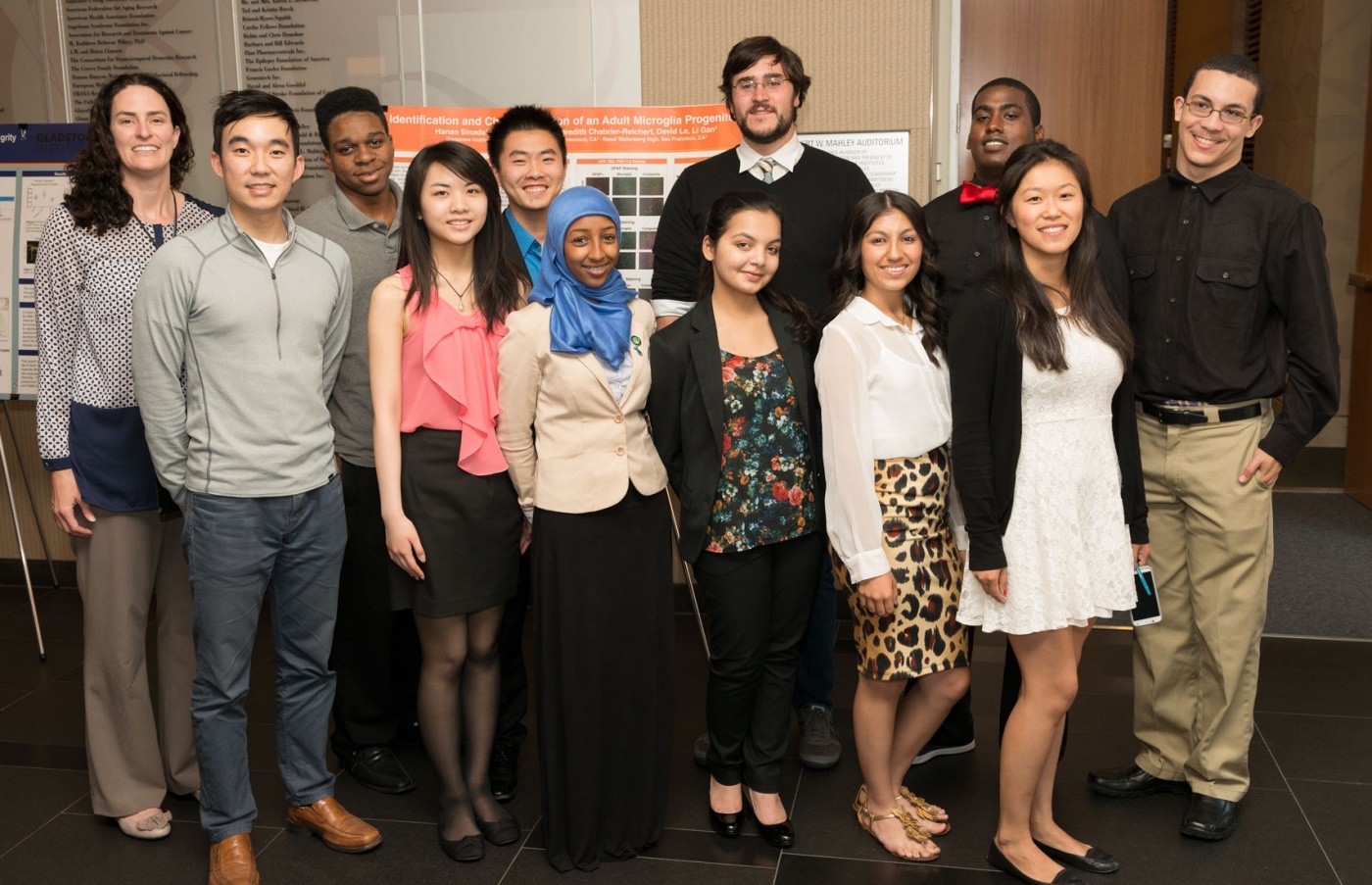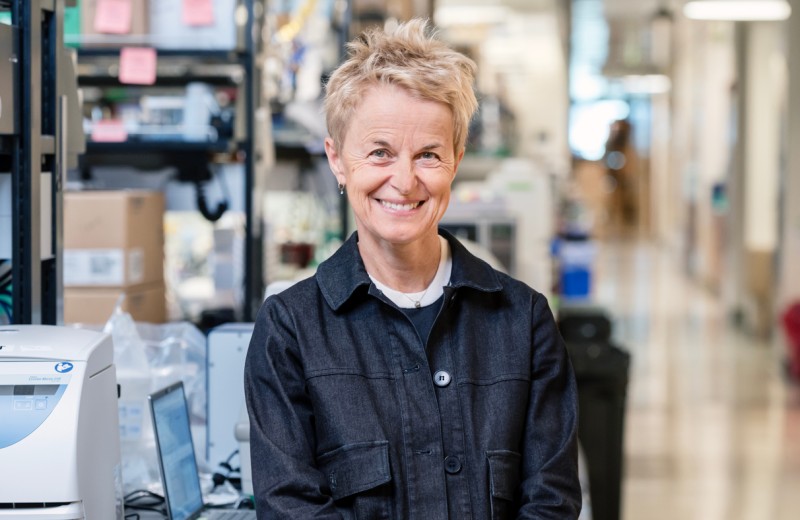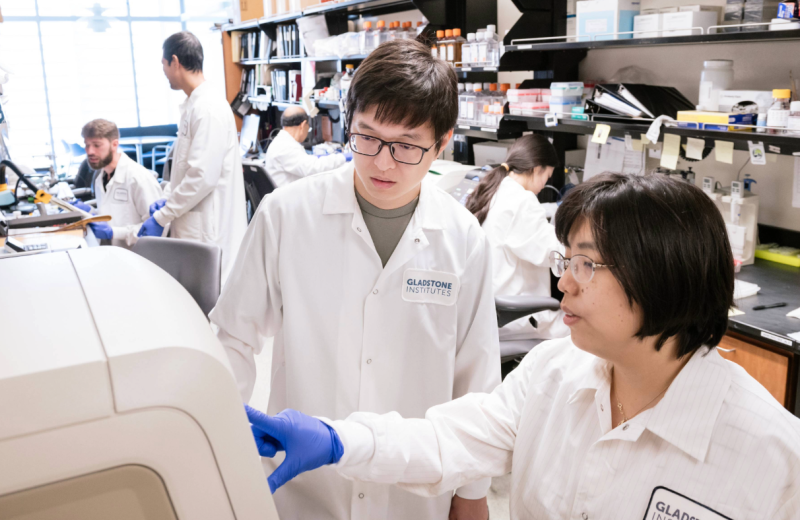Gladstone NOW: The Campaign Join Us on the Journey✕

Gladstone minority summer internship students and student outreach coordinators at the Diversity Intern Poster Session. [Photo: Chris Goodfellow]
Every morning for eight weeks this summer, Damon Williams traveled over 50 miles from his home in Brentwood to the Gladstone Institutes in San Francisco. He was more than happy to make the long commute though; working on a special project in the Gladstone Stem Cell Core, Williams helped develop skeletal muscle from mouse stem cells in order to study a specific protein involved in ALS, or Lou Gehrig’s disease. But Williams isn’t a lab technician or a postdoc, he’s a community college student.
Williams is part of PUMAS—Promoting Underrepresented Minorities Advancing in the Sciences—a unique new summer internship program at Gladstone that offers hands-on research experience to underrepresented community college students who intend to pursue a four-year degree in science. Started in 2014, the PUMAS program will be partially funded throughout its first five years by an NIH educational outreach grant, the first of its kind awarded to Gladstone specifically for outreach efforts
Currently enrolled in Los Medanos Community College, Williams says he became interested in science during his high school biology class, but he was unsure about how to move forward—and in which direction. After his eight weeks at Gladstone, Williams now feels he knows exactly what he wants to do: earn a PhD in biology and eventually become a principal investigator.
“It might sound cheesy, but this experience has been life-changing,” says Williams. “Before, I didn’t know what I wanted to do. Now I know the path I want to pursue and every single step I’m going to take to get there.”
Williams’ host investigator at Gladstone, Kathy Ivey, PhD, points to the diversity element of the program as being especially important.
“This is one of the earliest ways we can diversify the scientific workforce—by bringing in students who aren’t necessarily exposed to science and showing them that they have opportunities in the field,” Dr. Ivey notes. “By helping them identify with people who have chosen science as a career, we show them that they can follow this track as well.”
The new PUMAS program joins the existing Gladstone Summer Scholars (GSS) internship program, which has welcomed six underserved San Francisco public high school seniors every summer for the past seven years.
Kainat Shaikh, a 2014 GSS intern and student at Philip and Sala Burton High School in Bayview/Hunter’s Point, spent her summer working in the lab of Gladstone investigator JJ Miranda, PhD, tackling the problem of HIV latency. Latency occurs when a virus lies dormant within infected cells, no longer replicating but still posing a threat should it become reactivated. Currently, researchers are using the “shock and kill” method in the laboratory to try to force the virus out of hiding so that they can eradicate it from the cell. Complete virus reactivation has remained elusive though, and Shaikh worked with her mentors to discover why this is the case.
Perhaps even more important than the technical skills she gained is her newfound ability to think like a scientist, Shaikh says. “I’ve learned how to motivate myself, think creatively, and be patient, especially when an experiment isn’t working or I’m not getting the data that I want.”
Shaikh’s mentors—Gladstone postdoctoral fellow Kristin Keck, PhD and graduate student Stephanie Moquin—were drawn to the program by the dual opportunity to give back to the community and to spread the word on why basic science research is so important.
“To me, this is the best part of science—getting to teach and mentor,” says Dr. Keck. “I took part in a program like this when I was 16, and it really resonated with me. I wanted to be able to pass that opportunity on to the next generation of students, particularly those who might not otherwise have access to a research environment.”
Moquin adds, “There are a lot of really intelligent, science-minded people who are only focused on medical school, and they don’t realize that there’s this alternative career path of basic science research where you can help people by contributing to our wider understanding and knowledge of life.”
Both eight-week internship programs culminated in August with an open poster session where—just like real scientists—the interns presented their findings to Gladstone staff, family, and friends.
Shannon Noonan, the Education and Community Partnerships Manager who coordinates the programs, explains that events like this are what make Gladstone special. “This poster session is just another example of how Gladstone really goes the extra mile to give our interns an authentic experience,” says Noonan. “There aren’t many organizations that put this much time and resources into developing the careers of outstanding young students. Fortunately, we’re at a place that recognizes the value that these types of opportunities provide.”
Beyond Viruses: Expanding the Fight Against Infectious Diseases
Beyond Viruses: Expanding the Fight Against Infectious Diseases
The newly renamed Gladstone Infectious Disease Institute broadens its mission to address global health threats ranging from antibiotic resistance to infections that cause chronic diseases.
Institutional News News Release Cancer COVID-19 Hepatitis C HIV/AIDS Zika Virus Infectious DiseaseFueling Discovery at the Frontiers of Neuroscience: The NOMIS-Gladstone Fellowship Program
Fueling Discovery at the Frontiers of Neuroscience: The NOMIS-Gladstone Fellowship Program
The NOMIS-Gladstone Fellowship Program empowers early-career scientists to push the boundaries of neuroscience and unlock the brain’s deepest mysteries.
Institutional News Neurological Disease Mucke Lab NOMISGladstone Mourns the Loss of Founding Trustee Richard D. Jones
Gladstone Mourns the Loss of Founding Trustee Richard D. Jones
Jones lent Gladstone his time and expertise for nearly 50 years.
History Institutional News



